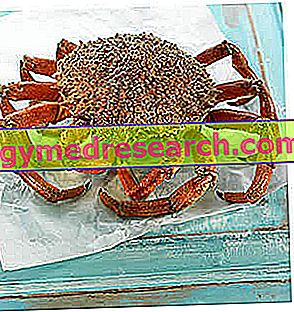The spider crab (or spider crab, in Latin Maja squinado ) is a crustacean belonging to the Brachiuri Decapods, widespread in the Mediterranean and the North Atlantic; it is the biggest crab (not rare examples of 2kg) of the aforementioned areas and, due to its delicacy, it is very present on the tables of lovers of crustaceans.

The name granseola has Venetian origins (Venice) and, more precisely, is the result of the union between the terms granzo (crab) and zéola (onion).
NB .
The spider crab is NOT the crab!
It is an animal that is slow to grow and has a rather curious life cycle; the granseola, at a young age, colonizes the areas of low rocky bottom, then, upon reaching maturity, it sinks down to depths of about 100m. It is fished especially during the winter with pots, trammel nets and (unfortunately) trawlers; in the spring months it returns close to the breakers to mate and lay eggs.
The spider crabs have a characteristic shape, impossible to be confused with the other Brachiuri Decapoda species. It strongly resembles a spider (not surprisingly, in Sicily it is also known as Tarantula ); the spider has a heart-shaped body (marginally serrated, maximum 25cm long and 18cm wide), with 6 pairs of long and thin attached legs (4 pairs for movement + 2 claws, they are long up to 200-300% of the body); on the back it has numerous tubercles and thorns, while frontally it protrudes with 2 cuneiform teeth. The male spider crab and the female spider crab are clearly distinguishable; the male is generally larger, has more powerful claws and a thin tail, while the female, on the average smaller size, has smaller claws and a wider tail under which the eggs are housed. The spider crab is brown in color, oscillating from orange to brown, with red shades; often, for camouflage, the carapace of the body is completely covered with algae (which in the culinary preparation must be properly removed). The spider crabs feed mainly on molluscs, fish and other invertebrates (such as sea urchins). WARNING! All the spider crabs are covered with hairs that, especially the masculine ones and probably more in the season of the mating, are hard and even sharp (very similar to the prickly pear spines, but longer and thicker). It is advisable to treat the spider crab "with gloves" and to grate it carefully (also on the legs) before cooking.
Granseola in gastronomy
Let us begin by pointing out that the spider crab, like other crustaceans, is a highly perishable product; often, shortly after his death, he acquires a strong smell of ammonia; what is worse, is that it is not always a question of bacterial proliferation (read the article: Crustaceans), but of an intrinsic degradation of free amino acids and muscle proteins. To avoid this adverse reaction, the spider crab (and not only that) is frequently marketed "alive"; not out of cruelty, but to prevent the meat from going into precocious decay or simply "emptying" (dehydration typical of crustaceans) of iterni liquids.
NB . A frozen / frozen spider crab is less valuable than a live spider crab but, on the other hand, it is always better than a dead and "pure" spider crab, recognizable by the presence of brown spots on the carapace.
There are many culinary preparations based on spider crab, but I personally believe that as the processing increases the organoleptic and taste properties of the food decrease. The only UNIVERSAL device that must be respected in cooking the spider crab is to establish before cooking how it should be consumed; to prepare a good boiled spider crab (queen of the Catalan crustaceans), it is essential to boil the animal WITHOUT pierce it and absolutely WITHOUT breaking it. The only useful intervention is the deep and accurate surface scraping of algae and hair on the carapace. Once boiled in hot water (better if in court buillon ), it is necessary to serve it whole (it always makes a certain figure) on a tray, and to provide the guests with a crustacean pincer and the appropriate forks to sprinkle it. On the contrary, if the spider crab were to be the primary ingredient of a soup or a sauce, it will be necessary (after having treated it as above):
- Separate the body from the legs and claws
- Brown all together with a bottom of celery, carrots, onion (garlic to taste), being careful not to break the shell
- Blend with white wine
- Continue cooking over a low heat with the addition of tomato (aromas to taste, I recommend fresh chilli and parsley at the end of cooking).
Nutritional content of the spider crab
The nutritional value of the spider crab is remarkable; it brings high biological value proteins, few fatty acids and some carbohydrates, but the respective energy density is however very limited. The vitamin content prefers the water-soluble elements of group B and the fat-soluble elements of the equivalent retinol type; the most important mineral salt is Iodine (I). However, the dietary suitability of the spider crab, like that of the granciporro, depends above all on the method with which it is eaten. Almost all the readers will have already tasted the meat of the spider crab, probably fleshed out and served in the carapace of the emptied body (typical presentation of the boiled spider crab); on the other hand, I suppose that they never asked themselves if the legs and the muscular chambers of the carapace were the only edible part of the food; in fact they are! Inside the head, excluding the digestive system (full of shells), the gonads of the spider crab (especially of the female) are very rich in orange or bright red waxy lipids; these, which are probably a "concentrate" of cholesterol, lecithin and polyunsaturated fatty acids, should not be consumed very frequently. On the other hand, if we think from an organoleptic and gustatory point of view, they represent a real delight that conveys to the palate a "purpurì" of absolutely incomparable flavors. We reiterate again that, if the granseola pulp can be consumed in moderation by anyone (except food allergies or special physiological conditions - pregnancy and lactation), its internal organs represent a food (or a portion of it) totally unsuitable for the diet of hypercholesterolemic.



